Family engagement and community partnerships key to mission
Lisa Bailey
PosAbilities program director Gord Tulloch sees a handful of trends in the developmental services sector pointing to a future characterized by greater community integration and different supports provided.
Amongst these trends are service integration and co-ordination, community partnerships, family engagement, and social enterprise and social finance.
Gord, who attended a Social Innovation and Social Finance study tour in Vancouver recently, sees much potential in the approach of focusing on assets and strengths and leveraging them to advance the mission of inclusion.
“Social enterprise and social finance is a totally new lens to look at evaluating, reviewing and analyzing what our assets are; and they’re not just the capital assets or the cash equity assets, they’re also our relationships, they’re our families,” says Gord, noting that there’s been “extraordinary interest in that sort of re-evaluation and looking at ways we can generate revenues to advance our social missions and doing it right.”
Political interests, he says, are looking at social enterprise, as are papers and conferences and he thinks “we’ll see a lot more of that in the future.”
Developing new, reciprocal relationships with families is an idea that is also bubbling up with organizations.
These are two-way connections and exchanges rather than families simply coming to receive services.
“Historically, we’ve only engaged families around advocacy and around services, but I think we’re going to be looking at family engagement now in an entirely new sort of way in terms of not only innovation and design but around how things need to become,” Gord says.
A call to forge more community partnerships is “absolutely critical” to inclusion and sustainability, he says.
Gord says partnerships traditionally have been more philanthropic or charitable in nature and many have been on a smaller scale involving, for example, non-profit organizations or businesses.
“We talk about community integration and community inclusion yet we don’t really work with community,” he says.
This insular approach will change so partnerships branch out into other areas such as arts and culture, aboriginal groups and multicultural communities.
“This is talking about more in terms of genuine community inclusion, genuine community integration, a genuine sense of belonging, solving social problems, and that means we’re going to have relationships with businesses and partners we’ve never had relationships with before,” Gord says.
Another important focus is service integration and co-ordination.
As with the health-care sector, Gord says that the social services sector has been comprised of thousands of service providers with all kinds of service configurations. In recent years, emphasis has been placed on integrating and co-ordinating services to help simplify this complex system, making it more efficient and easier to navigate.
– More to come on what Gord sees for the future of the sector
If you have a story to share or feedback on this article, please contact the newsroom at 800-294-0051, ext. 25, or e-mail lisa(at)axiomnews.ca.










